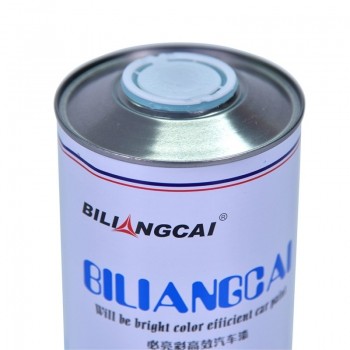Qingyuan Automobile Repair Paint Manufacturer Tells You About Commonly Used Abrasives for Surface Treatment Before Spraying
Before the workpiece is sprayed with water paint, it is often necessary to carefully treat the surface of the workpiece, which is called pre-treatment. The quality of pre-treatment affects the adhesion, appearance, moisture resistance, and corrosion resistance of the coating. After careful sorting of the appearance and general rough sorting of the workpiece, the coating can be compared using the exposure method, and the lifespan can differ by 4-5 times. The pre-treatment work is not done well, and rust will continue to spread under the coating, causing the coating to fall off in pieces. Due to the characteristics of water-based industrial paint, the requirements for the surface treatment of the substrate are relatively strict, and proper pre-treatment is crucial. Spray finishing is a commonly used pre-treatment method. Below is an introduction to the abrasive used for spray finishing. The abrasive used for blast cleaning has a wide range of applications, from crushed walnut shells, glass and slag, to various metal balls and sand, and even ceramic sand. However, only a few limited types are commonly used for surface treatment of coatings: quartz sand, copper slag, steel sand, steel balls, and corundum (aluminum oxide).
Quartz sand is a quartz particle formed by crushing and processing quartz stone. Quartz stone is a non-metallic mineral that is sturdy, wear-resistant, and chemically stable silicate mineral. Sharp quartz sand is a cheap and economical abrasive used in industrial construction, and is widely used in many countries. Quartz sand is a commonly used abrasive for blasting, so sandblasting has become a common term. The dust of quartz sand is fine, with a surface area of over 100m2/g that can be suspended in the air. If people inhale dust containing quartz sand for a long time, they will suffer from silicosis, which is gradually no longer used. Outdoor "on-site work" may occasionally allow the use of quartz sand, but operators and other personnel must be carefully maintained to avoid the influence of dust.

2. Copper ore slag: Copper ore slag, also known as copper ore sand, is a by-product of the copper tempering process. During the tempering and quenching processes, the slag is converted into iron silicate, which is the raw material for producing copper ore slag. Get used to organizing, rust removing, and strengthening the outdoor appearance of new and old steel.? After fine processing, it is also suitable for various finer spraying applications. Copper slag is a commonly used abrasive in open sandblasting, with a lower price and no free silicon, which does not pose a health hazard to human health.
3. Steel sand: Steel sand is formed by crushing high carbon cast steel shot into sand particles, which are then tempered to triple hardness (GH, GL, and GP) to meet different needs. Moderate hardness, strong toughness, impact resistance, can be repeatedly used several times, has good longevity, strong adhesion, fast sorting speed, low sand consumption, and does not break. The sorting workpiece has high brightness, and the skill effect is good. The processed steel sand is screened and sorted into 10 grades that meet SAE specifications to meet different spray treatment requirements. In the application of shot blasting equipment, GP and GL steel sand should be selected.
4. Steel Shot is a spherical particle made of special materials through special heat treatment. When manufacturing steel balls, the first step is to melt high-quality iron blocks, and then use high-pressure water to spray the molten steel into particles. The resulting balls are heated from scratch to purify and homogenize, and then quenched. The shot body after one quenching is dried and tempered from scratch in the furnace to reach the applicable hardness. The tempered steel shot is subjected to mechanical screening and reddening, which meets the 11 grades of SAE specifications for blast finishing. Steel shot is widely used for descaling and rust removal of steel workpieces before coating, and centrifugal shot blasting equipment is often used in this situation. The shape of the ball and its smaller hardness prevent the steel shot from causing significant wear on the equipment.
5. Corundum (aluminum oxide): Corundum has a frictional hardness of 9, which is the highest hardness substance found in nature so far, second only to diamonds in hardness. The impact of corundum on conventional corrosion is basically inert, so it can be used for sandblasting the surface of stainless steel or non-ferrous metal materials without causing rust pollution.
Article source: Qingyuan Automotive Repair Paint http://www.jinliangxincai.com/
-
08-25
Common problems with automotive repair paint
Why are the orange lines on the surface of the varnish so heavy after each spray? Why on earth? How can we prevent a decrease?Answer: The thinness of the varnish, the amount of paint produced by the s
-
06-05
The car repair paint manufacturer told you about the problem with water-based coatings
1. How long does it take for a skilled paint coating technician to master the operation of water paint?Generally, practice and understanding with less than half a sound can be mastered, and proficienc
-
05-31
Qingyuan Automobile Repair Paint Company tells you the steps for painting
Automotive Painting Process(1) Rust prevention and internal painting of the vehicle body: Depending on the condition of the vehicle body, it will be completed by a sheet metal worker.(2) Polishing and
-
05-12
Why does car repair paint lack luster?
If there is a lack of gloss on the surface of the originally flat and smooth car paint surface, especially during the process of car paint care, it can be observed under a microscope that the surface
